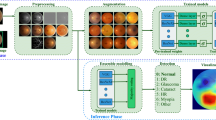Abstract
Retinal image quality assessment (RIQA) is the first step performed in retinal image processing systems necessary to assure that the processed images are suitable for analysis and medical diagnosis. RIQA algorithms created for controlled environments can result in degraded performance for cross-dataset experiments in which the train and test images have different resolutions. The effect of image resolution on the performance of four different RIQA algorithms, chosen to include generic, segmentation, and transform-based quality features, is studied using datasets of various resolutions. Analyses showed that for cross-dataset classifications, the performance of some RIQA algorithms was reduced by up to 50% in cases where the train and test dataset image resolutions were significantly different. A statistical analysis was conducted to study how the retinal image quality features are affected by image resolution which resulted in their categorization into resolution-dependent and resolution-independent features. Feature scaling was then introduced to overcome the transform-based RIQA algorithm’s cross-dataset performance degradation resulting in a 100% performance enhancement. Based on this study, the investigation and enhancement of the cross-dataset performance of RIQA algorithms are recommended as a standard part of their design in order to assure their performance reliability in processing images of various resolutions.


Similar content being viewed by others
References
Marrugo, A.G., Millan, M.S.: Retinal image analysis: preprocessing and feature extraction. J. Phys. Conf. Ser. 274(1), 012039 (2011). (IOP Publishing)
Yao, Z., et al.: Generic features for fundus image quality evaluation, Proceedings of 18th IEEE International Conference on e-Health Networking Applications and Services (Healthcom), pp. 1–6 (2016)
Bhaskaranand, M., et al.: EyeArt+ EyePACS: automated retinal image analysis for diabetic retinopathy screening in a telemedicine system, Proceedings of the Ophthalmic Medical Image Analysis Second International Workshop (OMIA), pp. 105–112 (2015)
Panwar, N., et al.: Fundus photography in the 21st century–a review of recent technological advances and their implications for worldwide healthcare. Telemed. e-Health 22(3), 198–208 (2015)
Wilson, C.L., et al.: Effect of resolution and image quality on combined optical and neural network fingerprint matching. Pattern Recognit. 33(2), 317–331 (2000)
Andreu Y., et al.: Analysis of the effect of image resolution on automatic face gender classification, Proceedings of the 22nd IEEE International Conference on Pattern Recognition (ICPR), pp. 273–278 (2014)
Raman, B., et al.: The effects of spatial resolution on an automated diabetic retinopathy screening system’s performance in detecting microaneurysms for diabetic retinopathy, Proceedings of the 17th IEEE Symposium on Computer-Based Medical Systems (CBMS), pp. 128–133 (2004)
Pauli, T.W., et al.: Effect of image compression and resolution on retinal vascular caliber. Investig. Ophthalmol. & Vis. Sci. (IOVS) 53(9), 5117–5123 (2012)
Pires, R., et al.: Retinal image quality analysis for automatic diabetic retinopathy detection, Proceedings of the 25th Conference on Graphics, Patterns and Images (SIBGRAPI), IEEE, pp. 229–236 (2012)
Dias, J.M.P., et al.: Retinal image quality assessment using generic image quality indicators. Inf. Fus. 19, 73–90 (2014)
Wang, S., et al.: Human visual system-based fundus image quality assessment of portable fundus camera photographs. IEEE Trans. Med. Imaging 35(4), 1046–1055 (2016)
Köhler, T., et al.: Automatic no-reference quality assessment for retinal fundus images using vessel segmentation, Proceedings of the IEEE 26th International Symposium on Computer-Based Medical Systems (CBMS), pp. 95–100 (2013)
Şevik, U., et al.: Identification of suitable fundus images using automated quality assessment methods. J. Biomed. Opt. SPIE 19(4), 046006 (2014)
Decenciere, E., et al.: Feedback on a publicly distributed image database: the Messidor database. Image Anal. Stereol. 33(3), 231–234 (2014)
Davis, H., et al.: Vision-based, real-time retinal image quality assessment, Proceedings of the 22nd IEEE International Symposium on Computer-Based Medical Systems (CBMS), pp. 1–6 (2009)
Veiga, D., et al.: Quality evaluation of digital fundus images through combined measures. J. Med. Imaging SPIE 1(1), 014001 (2014)
Abdel-Hamid, L., et al.: Retinal image quality assessment based on image clarity and content. J. Biomed. Opt. SPIE 21(9), 96007 (2016)
Haralick, R.M., et al.: Textural features for image classification. IEEE Trans. Syst. Man Cybern. 3(6), 610–621 (1973)
Fasih, M., et al.: Retinal image quality assessment using generic features, Proceedings of SPIE Medical Imaging, p 90352Z (2014)
Narvekar, N.D., Karam, L.J.: A no-reference perceptual image sharpness metric based on a cumulative probability of blur detection, IEEE International Workshop on Quality of Multimedia Experience (QoMEX), pp. 87-91 (2009)
Tang, X.: Texture information in run-length matrices. IEEE Trans. Image Process. 7(11), 1602–1609 (1998)
Zhu, X., Milanfar, P.: Automatic parameter selection for denoising algorithms using a no-reference measure of image content. IEEE Trans. Image Process. 19(12), 3116–3132 (2010)
Abdel-Hamid, L., et al.: No-reference wavelet based retinal image quality assessment, Proceedings of the 5th Eccomas Thematic Conference on Computational Vision and Medical Image Processing (VipIMAGE), pp. 123–130 (2015)
Nirmala, S.R., et al.: Wavelet weighted distortion measure for retinal images. Signal Image Video Process. 7(5), 1005–1014 (2013)
Hall, M., et al.: The WEKA data mining software: an update. ACM SIGKDD Explor. Newsl. 11(1), 10–18 (2009)
Miles, J.: R Squared, Adjusted R Squared, Wiley StatsRef: Statistics Reference Online
Author information
Authors and Affiliations
Corresponding author
Rights and permissions
About this article
Cite this article
Abdel-Hamid, L., El-Rafei, A., El-Ramly, S. et al. Performance dependency of retinal image quality assessment algorithms on image resolution: analyses and solutions. SIViP 12, 9–16 (2018). https://doi.org/10.1007/s11760-017-1124-5
Received:
Revised:
Accepted:
Published:
Issue Date:
DOI: https://doi.org/10.1007/s11760-017-1124-5




